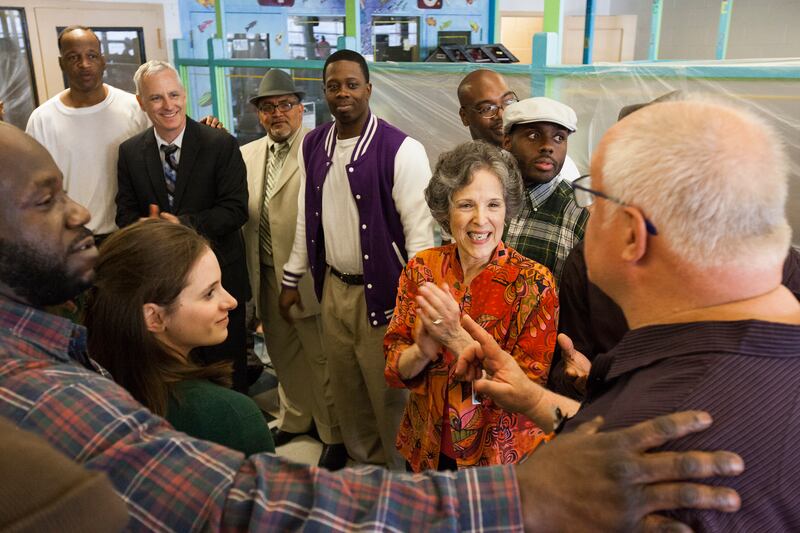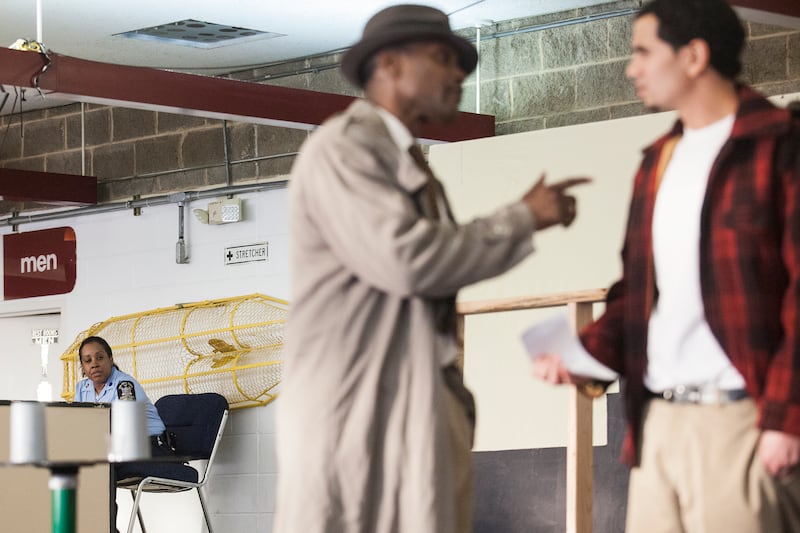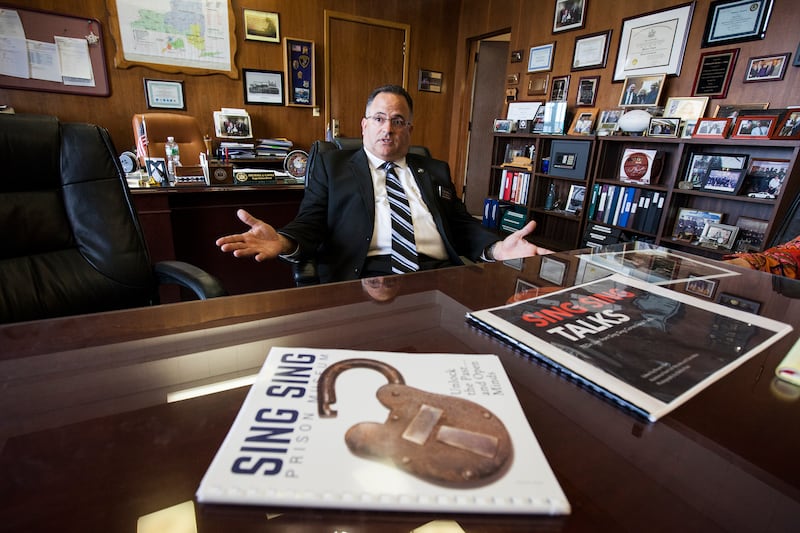A prison play feels a lot like a high school play. Except the actors get strip-searched before entering the auditorium, which in this case is the visiting room at Sing Sing, the maximum-security correctional facility in Ossining, New York. It’s here that an inmate production of On the Waterfront—Elia Kazan and Budd Schulberg’s famous dockworker crime drama—is set to be performed.
Getting inside the joint is easier for the audience, but just slightly. On the wall near the metal detectors, a large, grammatically haphazard sign in both English and Spanish lays out the ground rules: “Only one outfit can be worn into the visiting area. The following items are not permitted: No sharp objects, penknives-fingernail files, can openers, afro picks, pointy combs, etc. Cosmetics, lipstick, mascara, etc. Loose or opened cigarettes, cigarette lighters, rolling paper, food, candy, gum, etc. Large handbags, newspapaers [sic], playing cards, or toys. Lawyers and social workers will be allowed to bring in pens and papers.”
An enormous correctional officer in a light blue uniform shirt and navy pants stands behind a counter, peering inside battery compartments and hard drive cases for hidden contraband, then logging every piece of equipment, every memory card, every lens cap, every pad, every pen before allowing it in. This includes the costumes that will be worn onstage this evening, which have been brought in from outside and, for security purposes, must conform to a very specific set of guidelines.
ADVERTISEMENT
“No blue of any shade, because that’s what the CO’s [Correctional Officers] wear,” explains Katherine Vockins, executive director of Rehabilitation Through the Arts (RTA), the Katonah, New York-based nonprofit that runs Sing Sing’s drama program. “No gray, that’s what the lieutenants and captains wear. No black—you could ‘disappear’ at night. No green, because that’s the color of the state prison uniforms. And no orange, because those are the colors worn in the [city] jail system.”

Inmates adjust their costumes before going on stage.
Sarah Rogers/The Daily BeastSing Sing, an imposing stone pile known at one point as the “Bastille on the Hudson,” has long been one of America’s most notorious prisons. Yet, it has developed a surprising reputation among inmates as one of the best places in the state to do time. It’s close to the city, so friends and family can visit more easily than more remote upstate facilities. The CO’s are more ethnically diverse than those at other New York State prisons, which better reflects the demographic makeup of the inmates they oversee. And it’s one of only five correctional institutions in the state where RTA offers classes in art, writing, and theater. As 15th-century painter Albrecht Dürer said, “If man devotes himself to art, much evil is avoided that happens otherwise if one is idle.” Would this still hold true in 2017? Could something as simple as putting on a show really be the solution to helping violent felons turn their lives around?
To stage a play in a men’s facility like Sing Sing, Vockins looks for scripts with as few female roles as possible. (At the Bedford Hills Correctional Facility, the one women’s prison in which RTA operates, Vockins does the opposite.) A 2007 production of Of Mice and Men at the Woodbourne Correctional Facility used a Japanese-style bunraku puppet as a stand-in for Curley’s wife, the only female part. In tonight’s performance, the role of Edie Doyle will be played by Ellie Sachs, a volunteer from Brooklyn.

Catherine Vockins, Founder and Executive Director of Rehabilitation Through the Arts, joins the cast before they take the stage.
Sarah Rogers/The Daily BeastNearly 80 percent of the inmates at Sing Sing are here for violent crimes. Tonight, “Pop” Doyle will be played by Gary Stewart (second-degree murder; 25 years to life); he and two accomplices shot and killed a Syracuse cop in 1991 during a drug deal gone wrong. The role of Charley “the Gent” Malloy will be played by Lawrence Bartley (second-degree murder; 27 years to life), who killed a 15-year-old bystander during a shootout at a Nassau County movie theater on Christmas Day in 1990. Charley’s brother, Terry—the role made famous by Marlon Brando in the 1954 film—will be played by Jonathan Andujar (first-degree manslaughter; 25 years), who stabbed a man to death during a dispute outside a Queens nightclub in 2005.
Inside the visiting room, Darrian Bennett is getting ready to play both a judge and Gillette, an investigator with the Waterfront Crime Commission. Bennett, who says he prefers to be called “Plank,” is nine years into a 17-year bid for manslaughter. He decided to try his hand at acting after taking in a jailhouse production of The Wizard of Oz.
“There’s so much I could’ve learned while I was home, I just... didn’t,” Bennett says. “The things we have here, people pay a lot of money to learn in the street.”
The officers working in New York State prisons, who start at less than $40,000 a year, are well aware of this fact. “Some of them can get a little cynical” about some of the seemingly tonier offerings available to inmates while they work long hours to make ends meet, concedes Anthony Annucci, Acting Commissioner of the NYS Department of Corrections and Community Supervision (DOCCS). “Especially if there’s a college program. You know, you have to pay for it on the outside, but commit a felony and you get it for free.”
But since 95 percent of all inmates will eventually get out of prison, it pays to release educated, thoughtful adults back into the community. “When they’re treated like they’re actually part of something, and what they’re saying is being respected by others, they learn that they have something to give,” says Superintendent Michael Capra, Sing Sing’s warden. “There are many letdowns. But if you say, ‘The heck with you,’ well, that’s what their whole lives have been.”
“I Coulda Been a Contender”

A correctional officer looks on as inmates perform 'On the Waterfront.'
Sarah Rogers/The Daily BeastIt has taken the cast and crew five months to get here.
They rehearsed as a group twice a week, and stole a few minutes here and there to run lines wherever they could—in the yard, in the law library, on the cellblock. Lawrence Bartley describes a process that sounds a lot like method acting when he talks about preparing for the role of Charley Malloy, played by Rod Steiger in the original 1954 film. “I try to take on the persona of the character, try to act like he would,” Bartley says. “Unless it would be offensive.” (This is prison, after all.)
A low-rise stage has been set up by a crew of inmate carpenters and electricians, who sit around the perimeter of the room in case they’re needed. John Zoccoli (felony murder; 25-to-life) illustrated the playbill. Zoccoli, who doesn’t act but is part of RTA’s visual arts program, transferred to Sing Sing last year to enroll in a master’s program offered by the New York Theological Seminary. For his thesis, Zoccoli, who was part of a robbery crew that killed a young father during a 1998 carjacking, is designing an art therapy course for DOCCS to use in its facilities.
Tonight’s performance will be the last of three; the first two were staged earlier in the week for the inmate population. A handful of outsiders have been allowed to attend the final show each year since 2005, and about 200 are here tonight. Many are inmates’ relatives; there are a handful of local officials in the audience, including the town historian and the mayor of Ossining, along with a couple of women from the city who heard about the show on Leonard Lopate. Capra’s wife is here, and RTA members greet her by name. She appears to know most of them, as well. It’s a rare point of personal contact between inmates and the administration; as a rule, Capra says staff usually don’t even shake inmates’ hands.
There’s a problem with the count in one of the housing units, and a large chunk of the cast is held back until everyone is accounted for. In the meantime, the visitors, prison administrators, and inmates on the technical crew mingle by tables set out along the rear wall with coffee cake, fruit salad, cheese cubes, and cafeteria-style juice cups. There are urns of hot water for tea and instant coffee—decaf only, inmate and former highway worker Joseph Occhione (burglary; 16 years to life) points out. His green Red Kap-brand uniform pants are cinched up by a thick leather belt, putting the lie to the apparent myth that belts aren’t allowed in prison.
A tall fence covered in razor-sharp concertina wire stands just outside the windows, which are covered in a patchy haze of faded purplish protective film. A couple of hundred yards beyond is the Hudson River. When the performance finally begins, the lights don’t go down, since the COs need to keep watch over the inmates at all times. Robert Rose (second-degree murder; 25 years to life) works the soundboard on the far side of the room.

Jason Calkins speaks to the audience as a Narrator in 'On the Waterfront'
Sarah Rogers/The Daily BeastJason Calkins (second-degree murder; 21 years to life) takes the stage as the Waterfront Reporter, a narrator role later added by writer Budd Schulberg for the theatrical version of his original screenplay. Jonathan Andujar, as Terry Malloy, follows, and Carlos Hall (second-degree murder; 20 years to life), as dockworker Joey Doyle, is next. The dialogue on stage is interrupted now and again by a staticky voice coming across a COs walkie-talkie; trains plying Metro-North’s Hudson line rumble past every few minutes.
When Laron Rogers (second-degree murder; 25 years to life) enters the scene playing Policeman 1, he is not wearing a blue policeman’s uniform at all, per prison guidelines, but WWII-era Army dress khakis. For obvious reasons, there is very little, if any, actual contact during the show’s two fight scenes. And familiar moments take on new symbolism for those familiar with the actors’ pasts. “I coulda been a contender,” cries Andujar, who was still in his teens when he came to prison. “I could have been somebody. Instead of a bum. Which is what I am. Let’s face it.”
A short time later, Father Barry, played by Kenyatta Hughes, disarms Malloy, who is on his way to snuff out corrupt union boss Johnny Friendly (Jermaine Archer, second-degree murder; 22 years to life). “You wanna be a brave man? Firing a gun into another human being’s flesh isn’t brave,” Hughes admonishes. This line takes on a whole new level of meaning when you know Hughes is in here for fatally shooting a cabdriver in the head.
Hughes, who recently completed a master’s degree in professional studies, has been locked up for the past 23 years. He says he gets a lot out of exploring different emotions and perspectives through the characters he plays: “I already know what it’s like to be a slimeball.” Hughes will make his first appearance before the parole board in 2019. If he’s approved for release, the odds that he’ll return to prison are negligible.
RTA graduates who have been out of prison for over three years have a recidivism rate of less than 5 percent, compared to 40 percent statewide and nearly 60 percent nationally. Only 16 percent of prisoners nationwide have high-school diplomas; inmates in RTA earn their GEDs sooner in their sentences than other offenders, and are three times more likely than other prisoners to continue their educations. (A dollar spent on prison education saves $4-$5 in future incarceration costs, according to the Rand Corporation.) At Sing Sing, 65 percent of inmates taking academic programs started out in RTA; those with master’s degrees have a recidivism rate of—no, this is not a typo—between 0 and 0.1 percent.
“I remember one officer asking me, ‘So, are you making them better actors so they can pull the wool over our eyes?’” says RTA’s Vockins. “Another said, ‘Do you visit the victims’ families as often as you come here?’ It’s not that we don’t care about the victims, but we change people from the inside so when they come out, they don’t reoffend and create more victims.”
“This is not liberal vs. conservative, it’s evidence-based,” says Capra. “I’ve been doing this a long time and I know what direction we should be going in.”
The organization’s total annual budget is roughly $300,000, which comes primarily from individual donors, faith-based organizations, grants, and corporate sponsors like Eileen Fisher. About a quarter of that is covered by Albany. According to a study by associate professor Lorraine Moller of John Jay College, inmates entering the RTA program at Sing Sing were there for more serious crimes, and had higher levels of anger, than did others. Yet, they emerged with lower anger levels, and were written up by staff for fewer rules violations, than their peers. At the same time, RTA participants don’t feel like they’re being “worked on,” rather, they’re working on themselves.
“That RTA is not a therapy program, per se, is one of its great advantages,” wrote Moller. “Prisoners acquire a resistance to efforts to ‘civilize’ or ‘pacify’ them, so a program that fosters individuality, talent, personal growth and social responsibility is an indirect and rewarding method of rehabilitation.”
Second Chances

Superintendent Michael Capra discusses Sing Sing's arts programs ahead of the production of 'On the Waterfront.'
Sarah Rogers/The Daily BeastThings weren’t always this way. Once upon a time, inmates at Sing Sing were literally tortured by their jailers. In 1859, according to New York State archival documents, 107 of the facility’s 1,000 or so men were “bucked,” or immobilized in a crouching position with their wrists and ankles bound, then hung upside down; 40 were “crowned,” or had a metal cage locked around their heads and necks which dug painfully into their flesh and made laying down to sleep next to impossible; six were strung up by pulleys; and 69 were “showered,” an early form of waterboarding. Punishable infractions included such crimes as attempted escape, fighting, and sodomy, as well as lesser violations like talking, swearing, and insolence.
This brutal model began to change in 1919, when Lewis Lawes took over as Sing Sing’s warden. According to Ralph Blumenthal’s 2004 book, Miracle at Sing Sing: How One Man Transformed the Lives of America’s Most Dangerous Prisoners, Lawes believed strongly in second chances. He had his face shaved each morning by an inmate doing time for slitting a man’s throat. His younger daughter’s favorite babysitter was a convicted kidnapper. The family cook was at Sing Sing for murder.
Lawes established a Sunday night lecture series with scientists, academics, and military officers coming to speak to the prisoners. He appointed Charles Chapin, a one-time editor at the New York Evening World convicted of killing his wife, to resuscitate Sing Sing’s flagging in-house newspaper. The men planted gardens, tended an aviary, an intramural sports league took shape—Edwin “Alabama” Pitts, convicted of robbing a grocery store in New York City, went on to play Double-A ball after his release—and an inmate theater program program was created.
Needless to say, Lawes’ methods generated a fair bit of public criticism. But Lawes, an outspoken death penalty opponent who still oversaw more than 300 executions during his tenure, didn’t budge.
“‘Put him in a cell, lock him up and throw the key away’ is a theory that can be sustained from the standpoint of mere punishment for crime,” Lawes argued in a 1931 New York Times op-ed. “It is not a difficult task and does not require imagination. But when we are asked to maintain a high standard of health, when we are cautioned to return men to society better than they come to us, when we are directed to rebuild characters and remold men’s minds, we must have material to work with.”
Capra, the current warden, sees his mandate in much the same way. “There are 1,700 guys here, many very brilliant,” he says. “They’ve got a lot of talent, they just used it for the wrong things.”
As the final scene of the evening draws to a close, the audience gives the men a standing ovation. The entire troupe lines up on stage and joins hands. There’s Gregory Manning (second-degree kidnapping, second-degree robbery, first-degree burglary; 25 years fixed sentence) as Little Frankie, and Eric Lee (second-degree murder; 16 years to life) as Moose. Timmy Walker (second-degree murder, second-degree kidnapping, first-degree robbery; 46 years to life) and Floyd Lindsey (first-degree burglary, 20 years to life) stand nearby as Big Mac and Kayo Dugan. Together, the cast takes a series of deep, Broadway-style bows.
Afterward, a woman rushes over to James Williams (second-degree murder; 30 years to life), who doubled as Johnny’s bartender and thug “Slim” Sekulovich tonight.

Inmates smile and bow to applause at the end of 'On the Waterfront.'
Sarah Rogers/The Daily Beast“I’m so proud of you,” she says, wrapping Williams, who is up for parole next year, in a tight hug. While the NYS DOCCS Family Handbook says “brief kisses” are permitted, “prolonged kissing and what is commonly considered ‘necking’ or ‘petting’ is not,” so they keep it short.
The inmates circulate throughout the room, chatting with visitors and savoring the moment. Jason Calkins shakes dozens of hands, asking each guest how they enjoyed the show. For now, life inside seems almost normal for these men.
When the audience leaves, there’s another headcount, then another strip search, after which the cast and crew are escorted back to their cells. At 10:45 p.m., inmates once again, they lock-in for the night.






